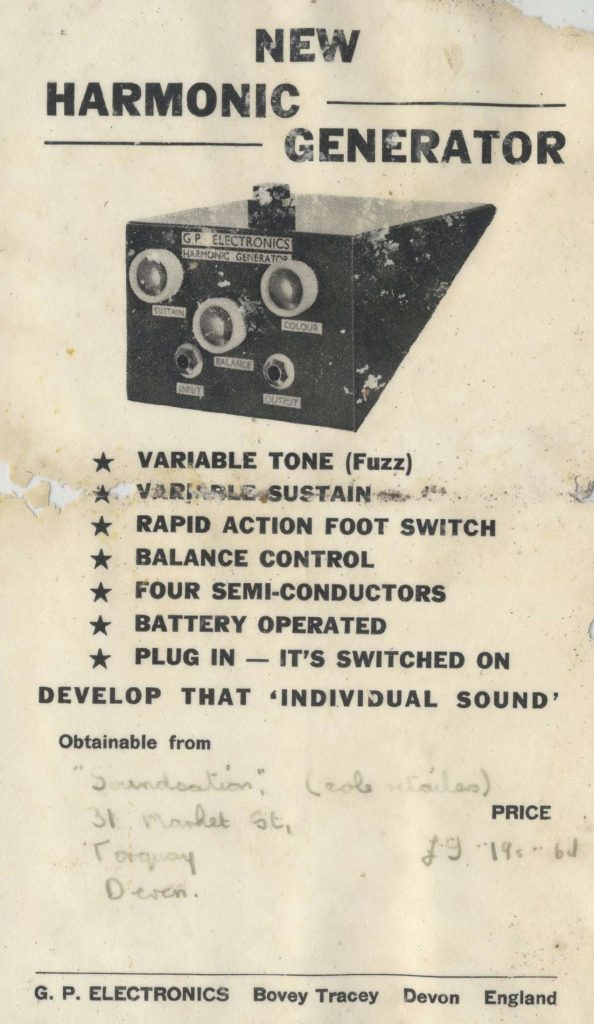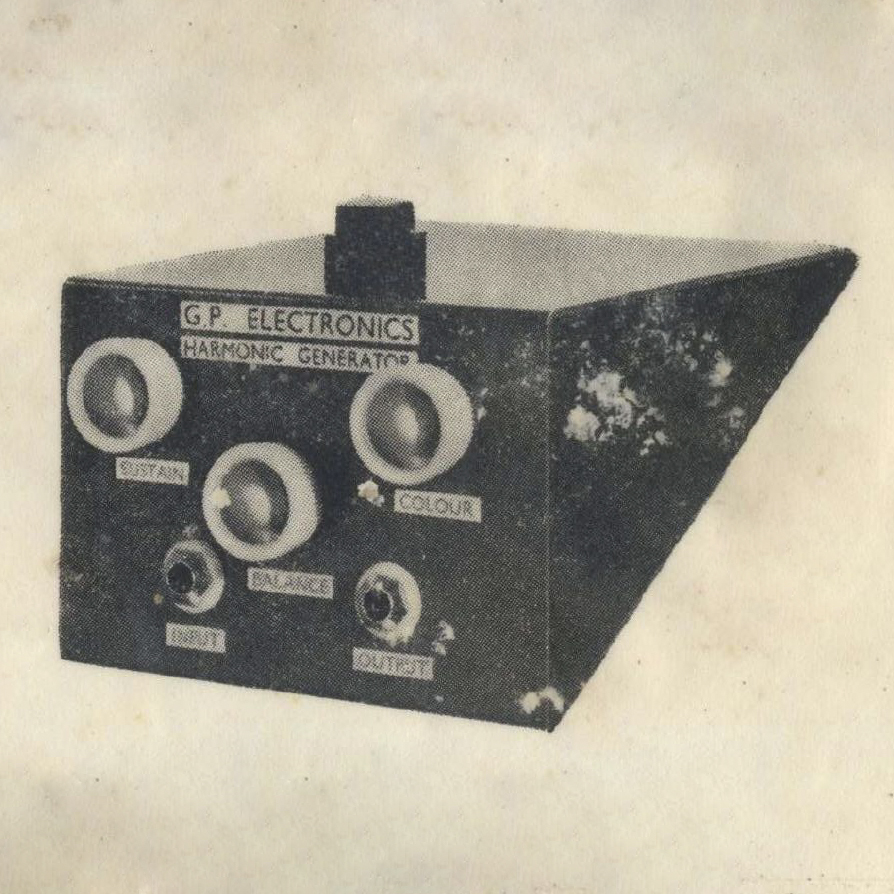Background
G. P. Electronics was a company in Bovey Tracey, Devon, founded by inventor Gerry Pope. G. P. manufactured guitar amplifiers and PA units during the 1960s & 70s, as well as treble & bass boosters, and a fuzz box, called the ‘Harmonic Generator’. Further information specifically about G. P. Electronics amplifiers can be found on Matthew North’s blog.
The majority of the information in this section comes thanks to John Wills, who has worked closely with Gerry Pope since joining G. P. Electronics as an assistant, in 1964, at age 14. More than fifty years later, Gerry Pope and John Wills are still working together, but have since moved on from electric guitar equipment to the hydroelectric power industry. The 1960s-era photo & advertisement on this page comes courtesy of John Wills.
Harmonic Generator
The Harmonic Generator was reportedly conceived in around 1964, after somebody referred Gerry Pope to an “American recording” of a fuzz sound. This places G. P.’s fuzz box amongst the very earliest offerings in the UK. Independent, strong anecdotal evidence confirms that the model was already available to the general public by around late 1965/early 1966.1
The enclosures of the Harmonic Generator were manufactured from a combination of folded aluminium and plywood, and all of the construction was done at the G. P. Electronics workshop. Earlier Harmonic Generator units were fitted, as pictured, with round cream control knobs; while later models came with moulded plastic knobs, and were also manufactured in-house.
G. P.’s fuzz boxes were sold at a number of local music shops around Devon, as well as by Boosey & Hawkes in London. A text advertisement for the Harmonic Generator, placed in NME, in November 1966, was arranged by local promoter, Lionel Digby.

Legacy


Distinctively shaped like a wedge of cheese, with three control knobs at the front, and a circuit described in a promotional leaflet as having “four semi-conductors”, the parallels with the Baldwin-Burns Buzzaround are fairly obvious.
Based on testimonies from the manufacturers, as well as from a former owner of a Harmonic Generator, we can ascertain that the G. P. fuzz box actually predated Jim Burns’ offering. Gerry Pope, himself, was reported to have returned from a trip to London expressing dismay after having discovered that the Burns guitar company had copied their product.
Burns’ Buzzaround pedals were manufactured in significantly larger numbers than the G. P. Electronics fuzz box, and would consequently go on to inspire other fuzz boxes during the 1960s. These including the highly successful British-built Vox Tone Bender MKIII & Sola Sound Tone Bender MKIV pedals, as well as the the Italian-built Elka Dizzy Tone.
The lasting legacy of this obscure fuzz box from Bovey Tracy can be seen in the very many versions of Tone Bender MKIII/MKIV & Buzzaround pedals that hobbyists and businesses continue to build to this day.
Notable users
G. P. Electronics Harmonic Generators were reportedly sold to Martin & Glen Turner, later of Wishbone Ash.
Three fuzz boxes were also received by the Shadows. John Rostill may have used the Harmonic Generator for the fuzz bass parts on the Shadows’ Bombay Duck & Tennessee Waltz, but because of the group’s affiliation with Burns Guitars, it’s also possible that they used the Baldwin-Burns Buzzaround as well. One eyewitness described, in 2009, seeing the Shadows perform in the late 1960s with what could have been a Harmonic Generator.2
One G. P. Harmonic Generator was also used at Advision Studios, in July 1966, for the recording of the New Vaudeville Band’s Winchester Cathedral.3
Reader appeal
At the time of writing, there are no known surviving exemplars of the G. P. Electronics Harmonic Generator. If readers might have any further knowledge or experiences with this obscure fuzz box, or perhaps even photos of any surviving exemplars, then please get in touch either via the form below, or by contacting me directly.
Thanks to Mick Clarke & Matthew North, as well as to John Wills & Gerry Pope.
